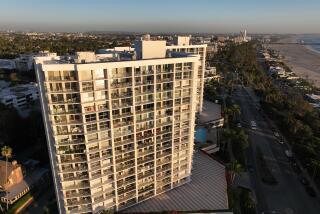Condos and Townhouses: What Is Difference?
- Share via
QUESTION: Thank goodness for your new column. Now maybe I can get an answer to my question: What is the difference between a condo and a townhouse?
I’ve asked many real estate agents and friends who own condos and what a mishmash of answers I have received. Please let me know the correct definition as we are interested in buying one or the other but not until we know for sure what we are getting into.
ANSWER: Confusion arises because community associations can have several different architectural designs and legal descriptions. Architectural styles vary from high-rise to low-rise, townhouse to single-family residences.
Condominium structures often have public entrances, common hallways and garage areas much like apartment buildings. A townhouse complex usually has four or five units in one or more buildings. Exterior doors lead directly to each unit with separate garages or carports. Single-family houses on individually-owned lots are sometimes controlled by a homeowners’ association.
Community associations are formed for maintenance and administration of land and buildings that are owned “in common” by several owners.
Membership is mandatory--if you purchase property in the association, you are automatically a member of the association with all the rights and responsibilities outlined in the Declaration of Covenants, Conditions and Restrictions (CC&Rs;). Owners pay assessments for the operation and maintenance of the commonly owned property.
How does legal ownership differ? When you read the legal documents of a “condominium” you will probably discover that the unit owners own a percentage of the land and building structure and common elements (landscaped areas, hallways, recreation rooms, swimming pools) plus the individual owner owns the inner walls and improvements within the condo unit.
This condominium concept has expanded to commercial and office condominiums and even marinas, called “dockominiums.”
In a “planned unit development” (PUD), usually called a “homeowners’ association,” the unit owners often own the land on which the individual unit sits, and a proportionate interest in the common elements. Townhouses and single-family residences are often PUDs. Owners in a planned unit development or homeowners association are often responsible for roof maintenance or landscaping around their individual unit. Check the association’s CC&Rs; for this information.
While we’re defining, let’s cover the cooperative concept. A “cooperative” is a nonprofit corporation which owns and pays property taxes on the land and building structure. The owners own a share of stock in the corporation, rather than a percentage of the property.
Owners “rent” their units pursuant to a proprietary lease with the corporation, and they pay regular assessments just like the condo or PUD owner. This basic legal difference provides certain advantages for the cooperative. Since the corporation owns all of the property, if the building requires major repairs, the cooperative has the capability of borrowing money secured by a mortgage on the entire building to make the repairs.
When you purchase in any community association, remember that you are legally bound to abide by the CC&Rs; and other legal restrictions that run with the property, so read them carefully. If you do not understand the documents, consult an attorney who specializes in common-interest real estate law.
Neighborhood Watch May Prevent Crime
Q: Our homeowners association is having some problems with vandalism and graffiti, etc. You mentioned Neighborhood Watch in a recent column. Where can our association obtain more information?
A: The Neighborhood Watch program encourages people to work together to combat crime within the neighborhood. Anyone can obtain information about it by calling your local police. Do not call 911. Call the non-emergency line.
Association Will Not Act on Complaint
Q: My wife and I belong to a homeowners association. Our neighbor has constructed a block wall between our properties. The footing of the wall is exposed on my side of the wall and there is no reasonable way for me to elevate my yard. The wall stands partially on my property and was built on top of my sprinklers. It has altered the ground drainage, resulting in flooding of my property when his lawn sprinklers are turned on. Lighting that shines in my window has been installed on a pilaster at the end of the wall.
We learned that our neighbor obtained construction approval from the association after the wall was already constructed. There are several CC&R; violations involved, but our association has not responded to our complaint other than to indicate that this is a “civil matter.” How do we make the homeowners association enforce the CC&Rs;?
A: First, if you haven’t already done so, file a written complaint with your association board of directors and request a written response. In its written response, the board of directors should tell you why they are declining action.
For instance, there may be a time limit imposed on the board by the association’s legal documents. It may be too late for the board to act.
Second, you should check with your city or county to see if building permits for this type of construction are required and whether permits were obtained. You may get some assistance from local government if the work was done without the proper permits.
Finally, you must determine the answer to this question: Is the aggravation and expense of your corrective repairs to the lawn and sprinkler system worth the additional time and expense of pursuing this with an attorney? Remember that you may be living in this association next to this neighbor for some time to come.
If you wish to file a lawsuit, your attorney can advise whether to sue the association, the offending neighbor or both.
Hickenbottom is president of the Greater Los Angeles chapter of the Community Associations Institute (CAI). Readers with questions or comments can write to her in care of “Condo Q&A;,” CAI, P.O. Box 84303, Los Angeles, 90073.
More to Read
Sign up for Essential California
The most important California stories and recommendations in your inbox every morning.
You may occasionally receive promotional content from the Los Angeles Times.






